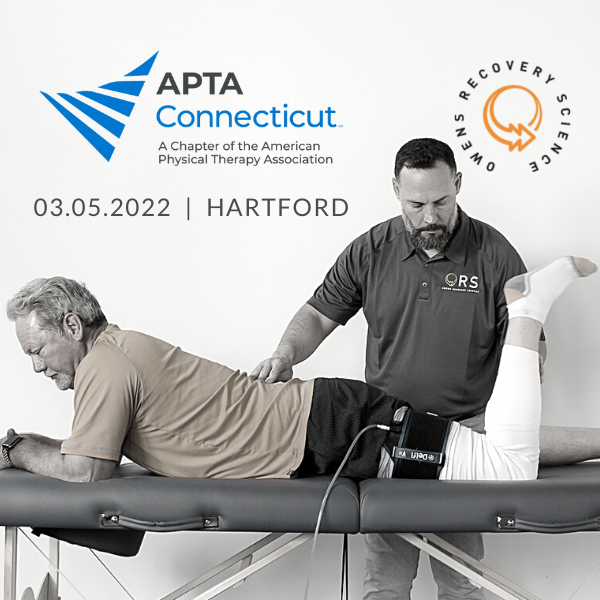Personalized Blood Flow Restriction Rehabilitation
3/5/20228:00 AM – 5:30 PM
Physical Therapy and Sports Medicine Centers
133 South Main Street
West Hartford, CT
Register

Current ACSM guidelines recommend that individuals perform resistance training at a load of >65% 1 repetition maximum (1RM) to achieve strength and hypertrophy gains. However, individuals undergoing rehabilitation after injury or surgery are often contraindicated to perform such loads. A novel technique, Blood Flow Restriction Training, has demonstrated that the utilization of a tourniquet system applied to the proximal portion of an exercising limb can allow individuals to gain strength and hypertrophy greater than work matched controls and similar to high load training while utilizing very low loads (20-30% 1 RM).
Outline Personalized Blood Flow Restriction Rehabilitation
8:00 Introduction to ORS and Blood Flow Restriction Training
8:15 History of Blood Flow Restriction and Evolution into Clinical Practice
8:40 BFR Methods: Occlusion Pressure
9:00 5 Minute Break
9:05 Lab One: Cuff Selection and Measuring Occlusion Pressure
9:40 5 Minute Break
9:45 BFR Methods: Intro to Passive, Endurance, and Resistance Applications
10:15 BFR Mechanisms: iEMG, Myostatin, IGF-1, MSC’s, Myocyte Swelling, VEGF, MPS
10:45 Safety: Clotting, Hemodynamics, Muscle Damage
11:15 Lab Two: Lower Extremity Exercise
12:00 Lunch Break (1 hour)
1:00 Skeletal Muscle: Understanding Anabolic Resistance
1:20 Prehab: Metabolic Stress, Scar, Blood Flow, Muscle Protein Synthesis
1:40 Acute Rehab: Timing and Research to Support Early Interventions
2:05 Lab Three: Upper Extremity Exercises
2:45 5 Minute Break
2:50 Chasing Optimal: Nutritional Considerations
3:05 Endurance Exercise Research and Understanding Key Parameters
3:30 BFR for Analgesia: Research and Potential Mechanisms
3:45 BFR Resistance Exercise: Potential Targets and Key Parameters
4:10 Effects for the Proximal Muscles: Theories and Research for the Hip and Shoulder
4:30 Clinical Reasoning: Entry Points and Decision Making on Indications
4:40 BFR and Bone
4:50 BFR and Tendon
5:00 Applications for Older Populations
5:15 Wrap Up and Group Exam 5:30 Adjournment
8.5 CEHs
By attending this one day training course for PBFR training, clinicians will:
- Translate the physiology behind mechanical tension compared to metabolic accumulation training and the downstream effects.
- Manipulate blood flow restriction protocols to create a local or systemic response within the soft tissues.
- Differentiate limb occlusion pressures objectively for each individual athlete/patient.
- Translate appropriate tourniquet safety measures to the outpatient/training room setting.
- Recommend and implement a rehabilitation blood flow restriction protocol for patients after injury or surgery.
Presented by
Ben Weatherford, DPT is currently the Clinical Education Coordinator for Owens Recovery Science (ORS), Inc a medical research, education, and device corporation. Ben has been teaching Personalized Blood Flow Restriction courses since 2015. He regularly trains and consults within professional and collegiate sports, the Department of Defense, and Healthcare systems in the US, Europe and Asia. Additionally, he assists in the management of a clinical research portfolio that includes more than 50 randomized clinical trials.
Current COVID protocols will be required and communicated to registered individuals.
REGISTER




